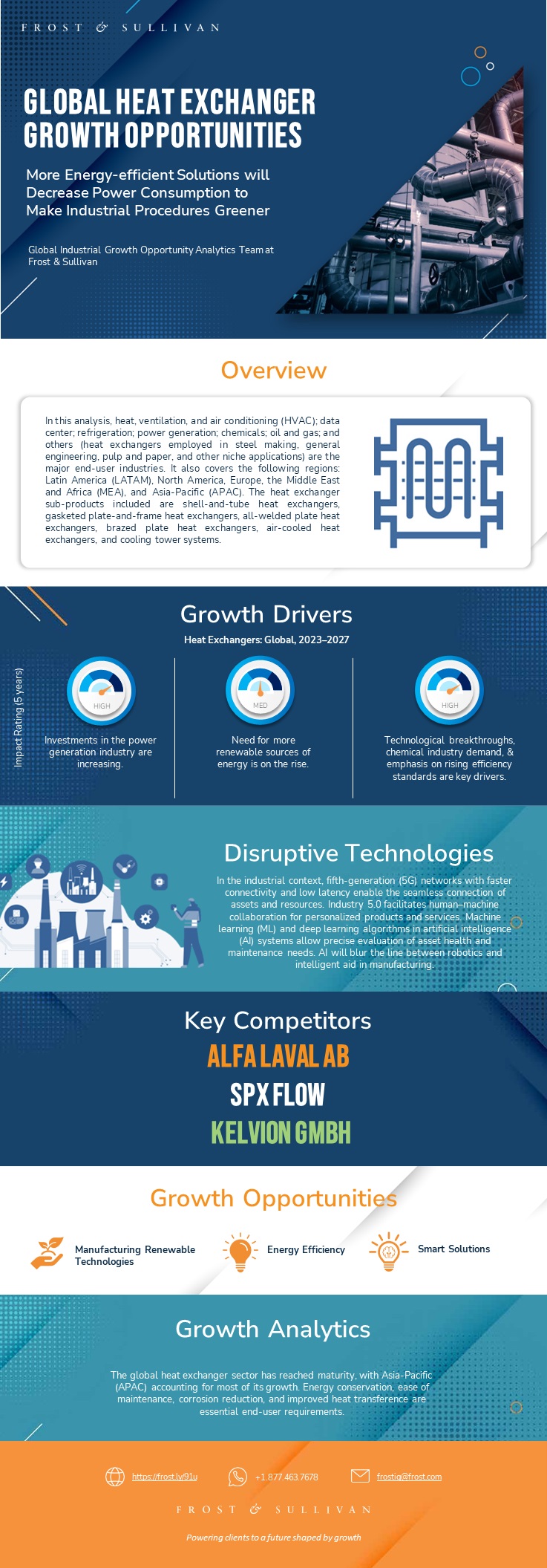Global Heat Exchanger Growth Opportunities
Global Heat Exchanger Growth Opportunities
More Energy-efficient Solutions will Decrease CAPEX and Power Consumption to Make Industrial Procedures Greener
31-May-2023
Global
Description
The global heat exchanger market has reached maturity, with Asia-Pacific (APAC) accounting for most of its growth. The emerging markets, where growth is high, are populated by significant market participants. Energy conservation, ease of maintenance, corrosion reduction, and improved heat transference are essential end-user requirements. Original equipment manufacturers (OEMs) with a history of gaining a competitive advantage by launching unique products and want to enjoy this type of exclusivity again are working to deliver innovative heat exchangers.
Frost & Sullivan discusses the numerous digital technologies market players can apply to drive revenue in this mature heat exchanger market. Competitive evaluation of heat exchangers is documented, which includes a look at the major market players and significant aspects that help them outperform their competition. The research also discusses the use of heat exchangers in green technology and the rise of heat exchangers in various renewable, alternative, and sustainable energy sources.
In this analysis, heat, ventilation, and air conditioning (HVAC); data center; refrigeration; power generation; chemicals; oil and gas; food and beverages; water and wastewater; pharmaceuticals; mining; marine and shipbuilding; and others (heat exchangers employed in steel making, general engineering, pulp and paper, and other niche applications) are the major end-user industries. This study covers the following regions: Latin America (LATAM), North America, Europe, the Middle East and Africa (MEA), and Asia-Pacific (APAC). The heat exchanger sub-products included in this study are shell-and-tube heat exchangers, gasketed plate-and-frame heat exchangers, all-welded plate heat exchangers, brazed plate heat exchangers, air-cooled heat exchangers, and cooling tower systems.
Author: Krishnan Ramanathan
RESEARCH: INFOGRAPHIC
This infographic presents a brief overview of the research, and highlights the key topics discussed in it.Click image to view it in full size

Table of Contents
Why is it Increasingly Difficult to Grow?
The Strategic Imperative 8™
The Impact of the Top 3 Strategic Imperatives on the Heat Exchanger Industry
Growth Opportunities Fuel the Growth Pipeline Engine™
Scope of Analysis
Market Segmentation
Market Segmentation by Region
Key Competitors
Growth Metrics
Distribution Channels
Growth Drivers
Growth Driver Analysis
Growth Driver Analysis (continued)
Growth Restraints
Growth Restraint Analysis
Forecast Assumptions
Revenue Forecast
Revenue Forecast Analysis
Key Developments
Revenue Forecast by Product
Revenue Forecast by Product Analysis
Revenue Forecast by Region
Revenue Forecast by Region Analysis
Revenue Forecast by Industry Vertical
Revenue Forecast by Industry Vertical Analysis
Revenue Forecast by Industry Vertical Analysis (continued)
Revenue Forecast by Industry Vertical Analysis (continued)
Revenue Forecast by Industry Vertical Analysis (continued)
Revenue Forecast by Industry Vertical Analysis (continued)
Pricing Trends and Forecast Analysis
Competitive Environment
Revenue Share
Revenue Share by Region
Revenue Share Analysis
Sustainability and Carbon Capture
Sustainability Initiatives from the Market Leader Alfa Laval
Sustainable Development Goals
Sustainable Development Goals (continued)
Concentrated Solar Power Farm
Growth Metrics
Revenue Forecast
Revenue Forecast by Industry Vertical
Revenue Forecast by Product Type
Revenue Forecast Analysis
Growth Metrics
Revenue Forecast
Revenue Forecast by Industry Vertical
Revenue Forecast by Product Type
Revenue Forecast Analysis
Growth Metrics
Revenue Forecast
Revenue Forecast by Industry Vertical
Revenue Forecast by Product Type
Revenue Forecast Analysis
Growth Metrics
Revenue Forecast
Revenue Forecast by Industry Vertical
Revenue Forecast by Product Type
Revenue Forecast Analysis
Growth Metrics
Revenue Forecast
Revenue Forecast by Industry Vertical
Revenue Forecast by Product Type
Revenue Forecast Analysis
Revenue by Industry Vertical
Growth Opportunity 1: Manufacturing Renewable Technologies
Growth Opportunity 1: Manufacturing Renewable Technologies (continued)
Growth Opportunity 2: Energy Efficiency
Growth Opportunity 2: Energy Efficiency (continued)
Growth Opportunity 3: Smart Solutions
Growth Opportunity 3: Smart Solutions (continued)
Your Next Steps
Why Frost, Why Now?
List of Exhibits
List of Exhibits (continued)
Legal Disclaimer
Popular Topics
| Author | Jinith Jayesh |
|---|---|
| Industries | Industrial Automation |
| No Index | No |
| Is Prebook | No |
| Keyword 1 | industrial heat exchanger |
| Keyword 2 | exchangers industries |
| Keyword 3 | heat exchanger market |
| Podcast | No |
| WIP Number | PDBE-01-00-00-00 |
 USD
USD GBP
GBP CNY
CNY EUR
EUR INR
INR JPY
JPY MYR
MYR ZAR
ZAR KRW
KRW THB
THB